Langara College Geography 1150: BC Highway System Expansion Analysis
VerifiedAdded on 2022/10/12
|9
|1815
|398
Essay
AI Summary
This essay provides a detailed analysis of the expansion of the British Columbia highway system. It explores the historical context, economic impacts, and various projects undertaken to improve transportation infrastructure. The essay highlights the importance of highway expansions like Highway 16, TransCanada Highway, the Kicking Horse Canyon Project, and the Okanagan Valley Corridor. It examines the investments made, the goals of these projects (such as improved safety and efficiency), and their effects on businesses and families across the province. The essay also references tables and figures to support its findings and concludes by emphasizing the significance of these developments for British Columbia's economic growth and connectivity. The essay is based on research and provides insights into the Ministry of Transport and Infrastructure's efforts in building a competitive, safe, reliable, and efficient transportation network.
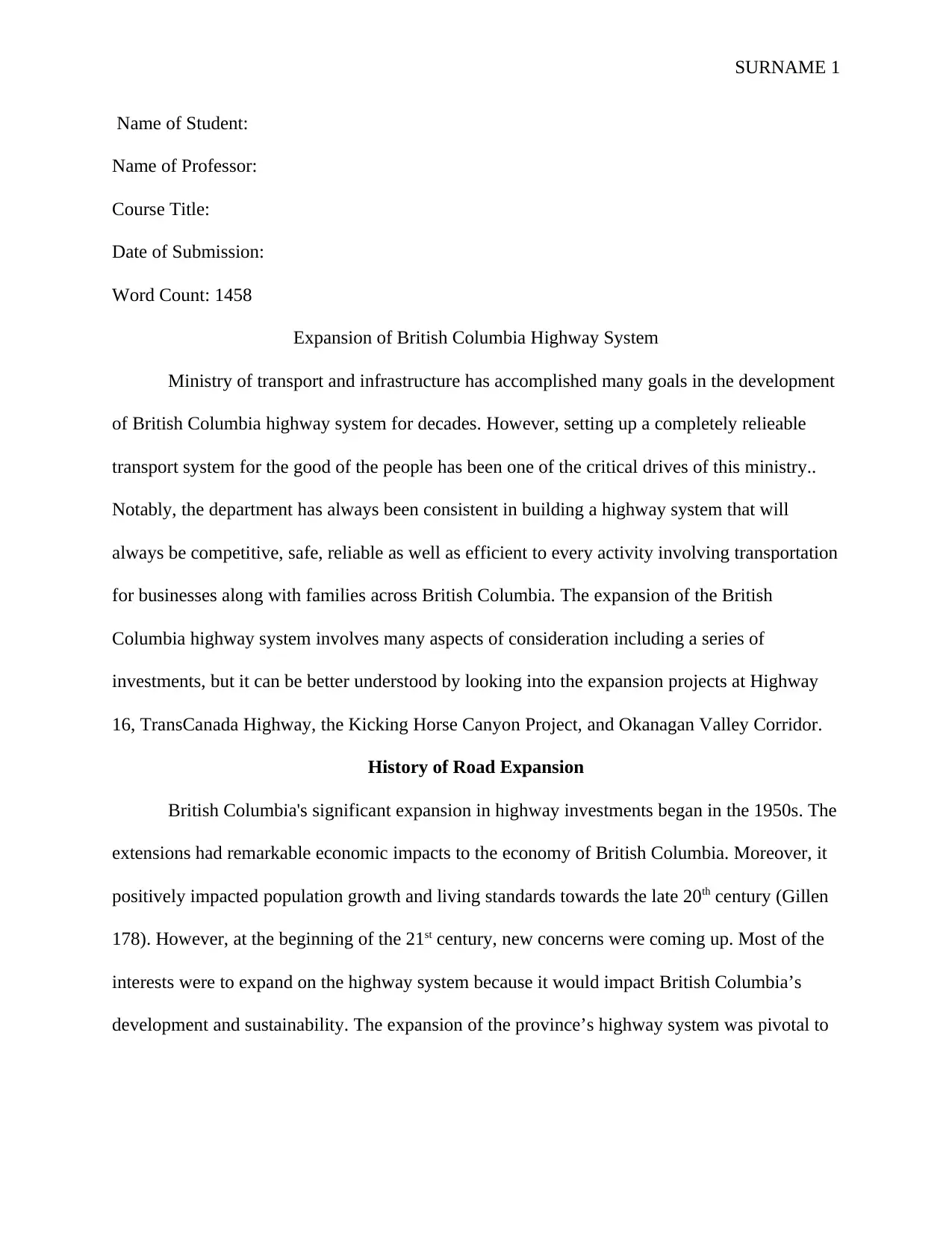
SURNAME 1
Name of Student:
Name of Professor:
Course Title:
Date of Submission:
Word Count: 1458
Expansion of British Columbia Highway System
Ministry of transport and infrastructure has accomplished many goals in the development
of British Columbia highway system for decades. However, setting up a completely relieable
transport system for the good of the people has been one of the critical drives of this ministry..
Notably, the department has always been consistent in building a highway system that will
always be competitive, safe, reliable as well as efficient to every activity involving transportation
for businesses along with families across British Columbia. The expansion of the British
Columbia highway system involves many aspects of consideration including a series of
investments, but it can be better understood by looking into the expansion projects at Highway
16, TransCanada Highway, the Kicking Horse Canyon Project, and Okanagan Valley Corridor.
History of Road Expansion
British Columbia's significant expansion in highway investments began in the 1950s. The
extensions had remarkable economic impacts to the economy of British Columbia. Moreover, it
positively impacted population growth and living standards towards the late 20th century (Gillen
178). However, at the beginning of the 21st century, new concerns were coming up. Most of the
interests were to expand on the highway system because it would impact British Columbia’s
development and sustainability. The expansion of the province’s highway system was pivotal to
Name of Student:
Name of Professor:
Course Title:
Date of Submission:
Word Count: 1458
Expansion of British Columbia Highway System
Ministry of transport and infrastructure has accomplished many goals in the development
of British Columbia highway system for decades. However, setting up a completely relieable
transport system for the good of the people has been one of the critical drives of this ministry..
Notably, the department has always been consistent in building a highway system that will
always be competitive, safe, reliable as well as efficient to every activity involving transportation
for businesses along with families across British Columbia. The expansion of the British
Columbia highway system involves many aspects of consideration including a series of
investments, but it can be better understood by looking into the expansion projects at Highway
16, TransCanada Highway, the Kicking Horse Canyon Project, and Okanagan Valley Corridor.
History of Road Expansion
British Columbia's significant expansion in highway investments began in the 1950s. The
extensions had remarkable economic impacts to the economy of British Columbia. Moreover, it
positively impacted population growth and living standards towards the late 20th century (Gillen
178). However, at the beginning of the 21st century, new concerns were coming up. Most of the
interests were to expand on the highway system because it would impact British Columbia’s
development and sustainability. The expansion of the province’s highway system was pivotal to
Paraphrase This Document
Need a fresh take? Get an instant paraphrase of this document with our AI Paraphraser
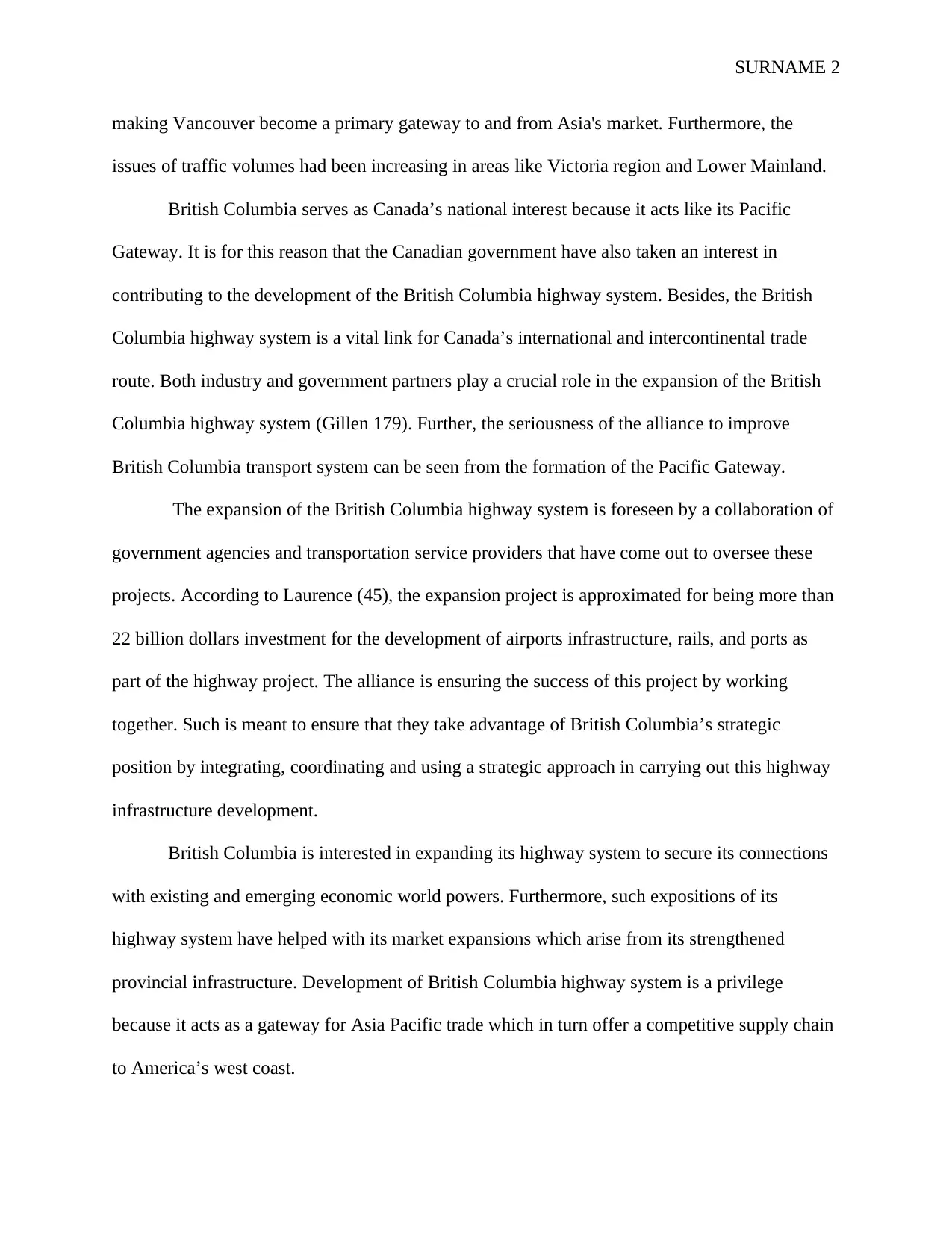
SURNAME 2
making Vancouver become a primary gateway to and from Asia's market. Furthermore, the
issues of traffic volumes had been increasing in areas like Victoria region and Lower Mainland.
British Columbia serves as Canada’s national interest because it acts like its Pacific
Gateway. It is for this reason that the Canadian government have also taken an interest in
contributing to the development of the British Columbia highway system. Besides, the British
Columbia highway system is a vital link for Canada’s international and intercontinental trade
route. Both industry and government partners play a crucial role in the expansion of the British
Columbia highway system (Gillen 179). Further, the seriousness of the alliance to improve
British Columbia transport system can be seen from the formation of the Pacific Gateway.
The expansion of the British Columbia highway system is foreseen by a collaboration of
government agencies and transportation service providers that have come out to oversee these
projects. According to Laurence (45), the expansion project is approximated for being more than
22 billion dollars investment for the development of airports infrastructure, rails, and ports as
part of the highway project. The alliance is ensuring the success of this project by working
together. Such is meant to ensure that they take advantage of British Columbia’s strategic
position by integrating, coordinating and using a strategic approach in carrying out this highway
infrastructure development.
British Columbia is interested in expanding its highway system to secure its connections
with existing and emerging economic world powers. Furthermore, such expositions of its
highway system have helped with its market expansions which arise from its strengthened
provincial infrastructure. Development of British Columbia highway system is a privilege
because it acts as a gateway for Asia Pacific trade which in turn offer a competitive supply chain
to America’s west coast.
making Vancouver become a primary gateway to and from Asia's market. Furthermore, the
issues of traffic volumes had been increasing in areas like Victoria region and Lower Mainland.
British Columbia serves as Canada’s national interest because it acts like its Pacific
Gateway. It is for this reason that the Canadian government have also taken an interest in
contributing to the development of the British Columbia highway system. Besides, the British
Columbia highway system is a vital link for Canada’s international and intercontinental trade
route. Both industry and government partners play a crucial role in the expansion of the British
Columbia highway system (Gillen 179). Further, the seriousness of the alliance to improve
British Columbia transport system can be seen from the formation of the Pacific Gateway.
The expansion of the British Columbia highway system is foreseen by a collaboration of
government agencies and transportation service providers that have come out to oversee these
projects. According to Laurence (45), the expansion project is approximated for being more than
22 billion dollars investment for the development of airports infrastructure, rails, and ports as
part of the highway project. The alliance is ensuring the success of this project by working
together. Such is meant to ensure that they take advantage of British Columbia’s strategic
position by integrating, coordinating and using a strategic approach in carrying out this highway
infrastructure development.
British Columbia is interested in expanding its highway system to secure its connections
with existing and emerging economic world powers. Furthermore, such expositions of its
highway system have helped with its market expansions which arise from its strengthened
provincial infrastructure. Development of British Columbia highway system is a privilege
because it acts as a gateway for Asia Pacific trade which in turn offer a competitive supply chain
to America’s west coast.
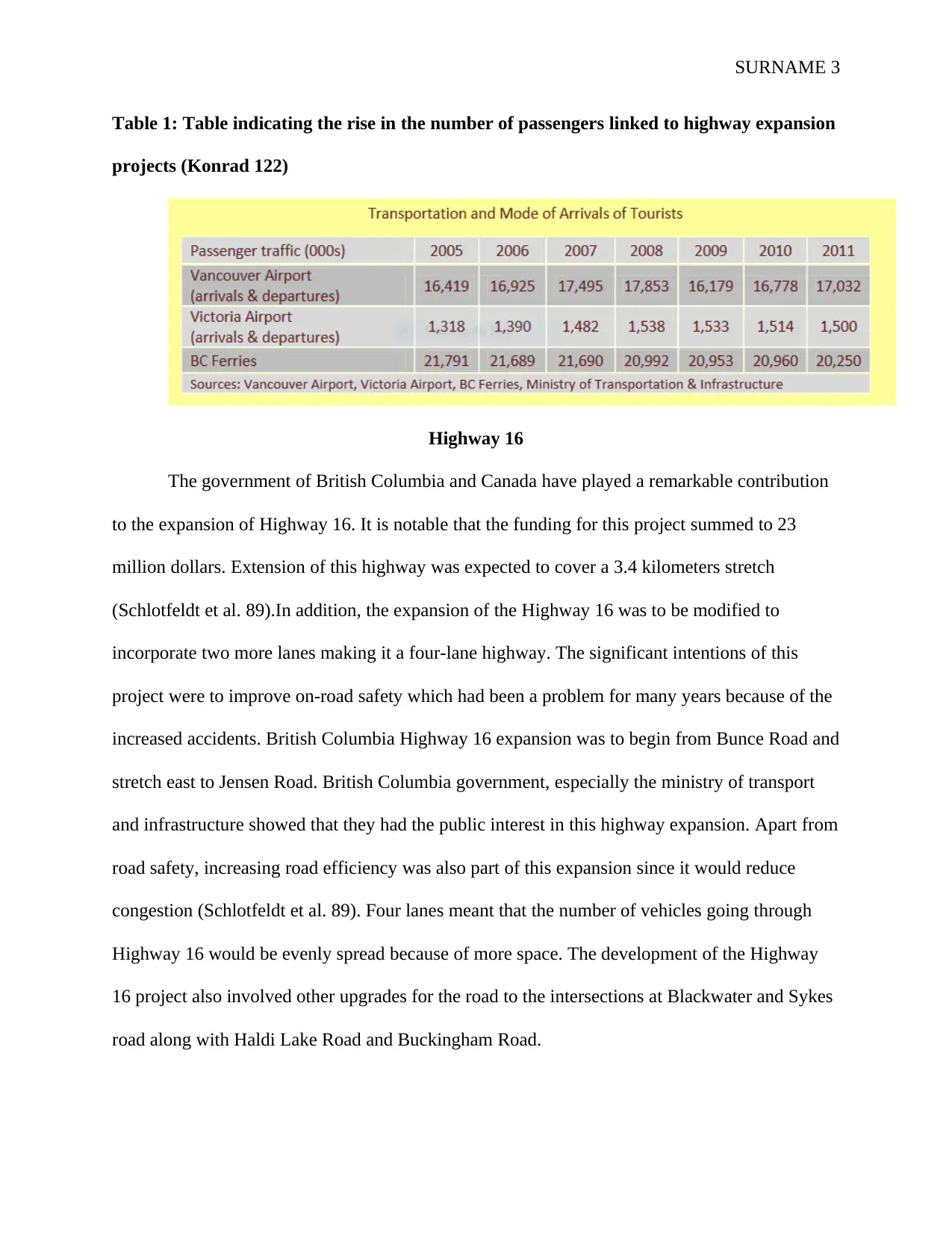
SURNAME 3
Table 1: Table indicating the rise in the number of passengers linked to highway expansion
projects (Konrad 122)
Highway 16
The government of British Columbia and Canada have played a remarkable contribution
to the expansion of Highway 16. It is notable that the funding for this project summed to 23
million dollars. Extension of this highway was expected to cover a 3.4 kilometers stretch
(Schlotfeldt et al. 89).In addition, the expansion of the Highway 16 was to be modified to
incorporate two more lanes making it a four-lane highway. The significant intentions of this
project were to improve on-road safety which had been a problem for many years because of the
increased accidents. British Columbia Highway 16 expansion was to begin from Bunce Road and
stretch east to Jensen Road. British Columbia government, especially the ministry of transport
and infrastructure showed that they had the public interest in this highway expansion. Apart from
road safety, increasing road efficiency was also part of this expansion since it would reduce
congestion (Schlotfeldt et al. 89). Four lanes meant that the number of vehicles going through
Highway 16 would be evenly spread because of more space. The development of the Highway
16 project also involved other upgrades for the road to the intersections at Blackwater and Sykes
road along with Haldi Lake Road and Buckingham Road.
Table 1: Table indicating the rise in the number of passengers linked to highway expansion
projects (Konrad 122)
Highway 16
The government of British Columbia and Canada have played a remarkable contribution
to the expansion of Highway 16. It is notable that the funding for this project summed to 23
million dollars. Extension of this highway was expected to cover a 3.4 kilometers stretch
(Schlotfeldt et al. 89).In addition, the expansion of the Highway 16 was to be modified to
incorporate two more lanes making it a four-lane highway. The significant intentions of this
project were to improve on-road safety which had been a problem for many years because of the
increased accidents. British Columbia Highway 16 expansion was to begin from Bunce Road and
stretch east to Jensen Road. British Columbia government, especially the ministry of transport
and infrastructure showed that they had the public interest in this highway expansion. Apart from
road safety, increasing road efficiency was also part of this expansion since it would reduce
congestion (Schlotfeldt et al. 89). Four lanes meant that the number of vehicles going through
Highway 16 would be evenly spread because of more space. The development of the Highway
16 project also involved other upgrades for the road to the intersections at Blackwater and Sykes
road along with Haldi Lake Road and Buckingham Road.
⊘ This is a preview!⊘
Do you want full access?
Subscribe today to unlock all pages.

Trusted by 1+ million students worldwide
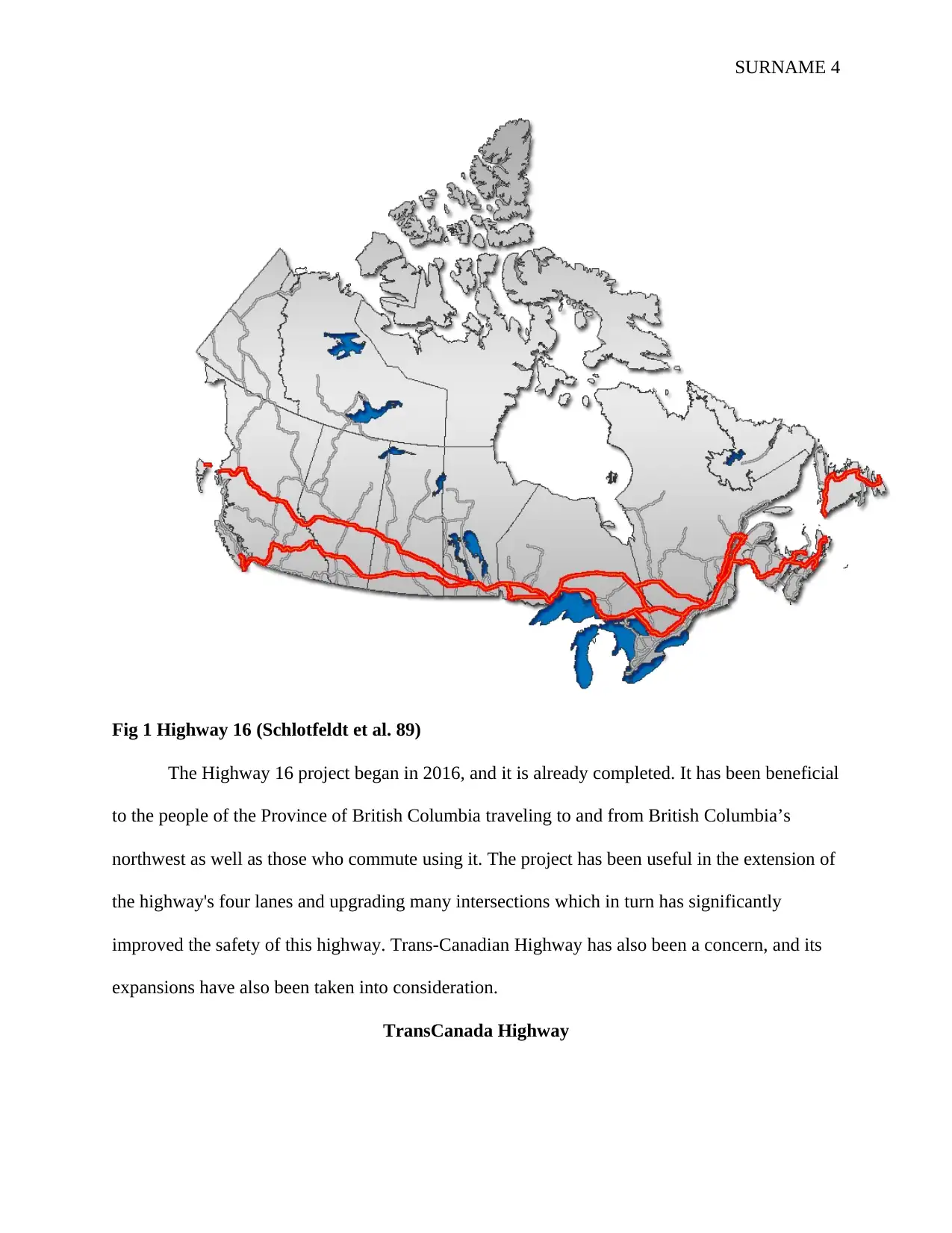
SURNAME 4
Fig 1 Highway 16 (Schlotfeldt et al. 89)
The Highway 16 project began in 2016, and it is already completed. It has been beneficial
to the people of the Province of British Columbia traveling to and from British Columbia’s
northwest as well as those who commute using it. The project has been useful in the extension of
the highway's four lanes and upgrading many intersections which in turn has significantly
improved the safety of this highway. Trans-Canadian Highway has also been a concern, and its
expansions have also been taken into consideration.
TransCanada Highway
Fig 1 Highway 16 (Schlotfeldt et al. 89)
The Highway 16 project began in 2016, and it is already completed. It has been beneficial
to the people of the Province of British Columbia traveling to and from British Columbia’s
northwest as well as those who commute using it. The project has been useful in the extension of
the highway's four lanes and upgrading many intersections which in turn has significantly
improved the safety of this highway. Trans-Canadian Highway has also been a concern, and its
expansions have also been taken into consideration.
TransCanada Highway
Paraphrase This Document
Need a fresh take? Get an instant paraphrase of this document with our AI Paraphraser
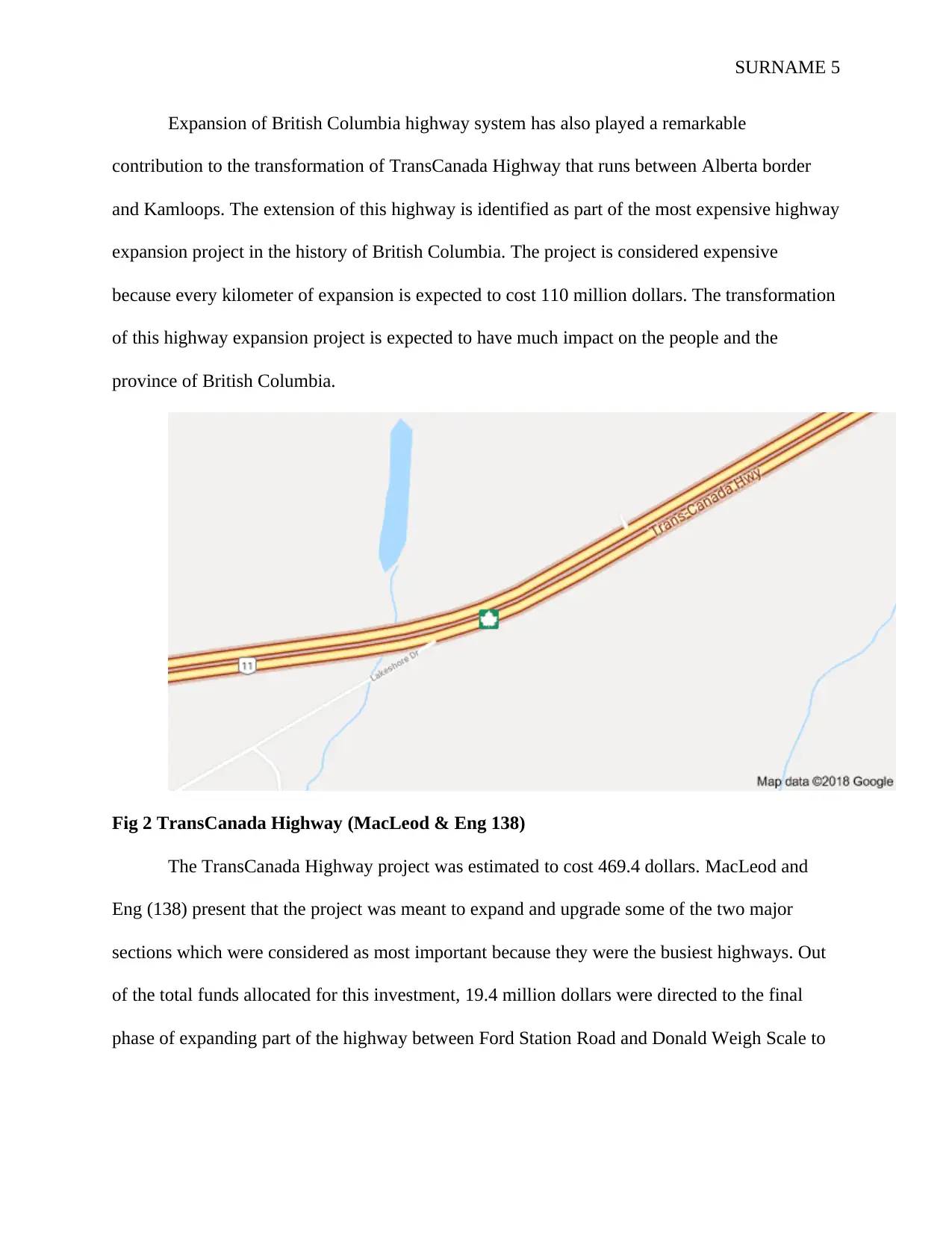
SURNAME 5
Expansion of British Columbia highway system has also played a remarkable
contribution to the transformation of TransCanada Highway that runs between Alberta border
and Kamloops. The extension of this highway is identified as part of the most expensive highway
expansion project in the history of British Columbia. The project is considered expensive
because every kilometer of expansion is expected to cost 110 million dollars. The transformation
of this highway expansion project is expected to have much impact on the people and the
province of British Columbia.
Fig 2 TransCanada Highway (MacLeod & Eng 138)
The TransCanada Highway project was estimated to cost 469.4 dollars. MacLeod and
Eng (138) present that the project was meant to expand and upgrade some of the two major
sections which were considered as most important because they were the busiest highways. Out
of the total funds allocated for this investment, 19.4 million dollars were directed to the final
phase of expanding part of the highway between Ford Station Road and Donald Weigh Scale to
Expansion of British Columbia highway system has also played a remarkable
contribution to the transformation of TransCanada Highway that runs between Alberta border
and Kamloops. The extension of this highway is identified as part of the most expensive highway
expansion project in the history of British Columbia. The project is considered expensive
because every kilometer of expansion is expected to cost 110 million dollars. The transformation
of this highway expansion project is expected to have much impact on the people and the
province of British Columbia.
Fig 2 TransCanada Highway (MacLeod & Eng 138)
The TransCanada Highway project was estimated to cost 469.4 dollars. MacLeod and
Eng (138) present that the project was meant to expand and upgrade some of the two major
sections which were considered as most important because they were the busiest highways. Out
of the total funds allocated for this investment, 19.4 million dollars were directed to the final
phase of expanding part of the highway between Ford Station Road and Donald Weigh Scale to
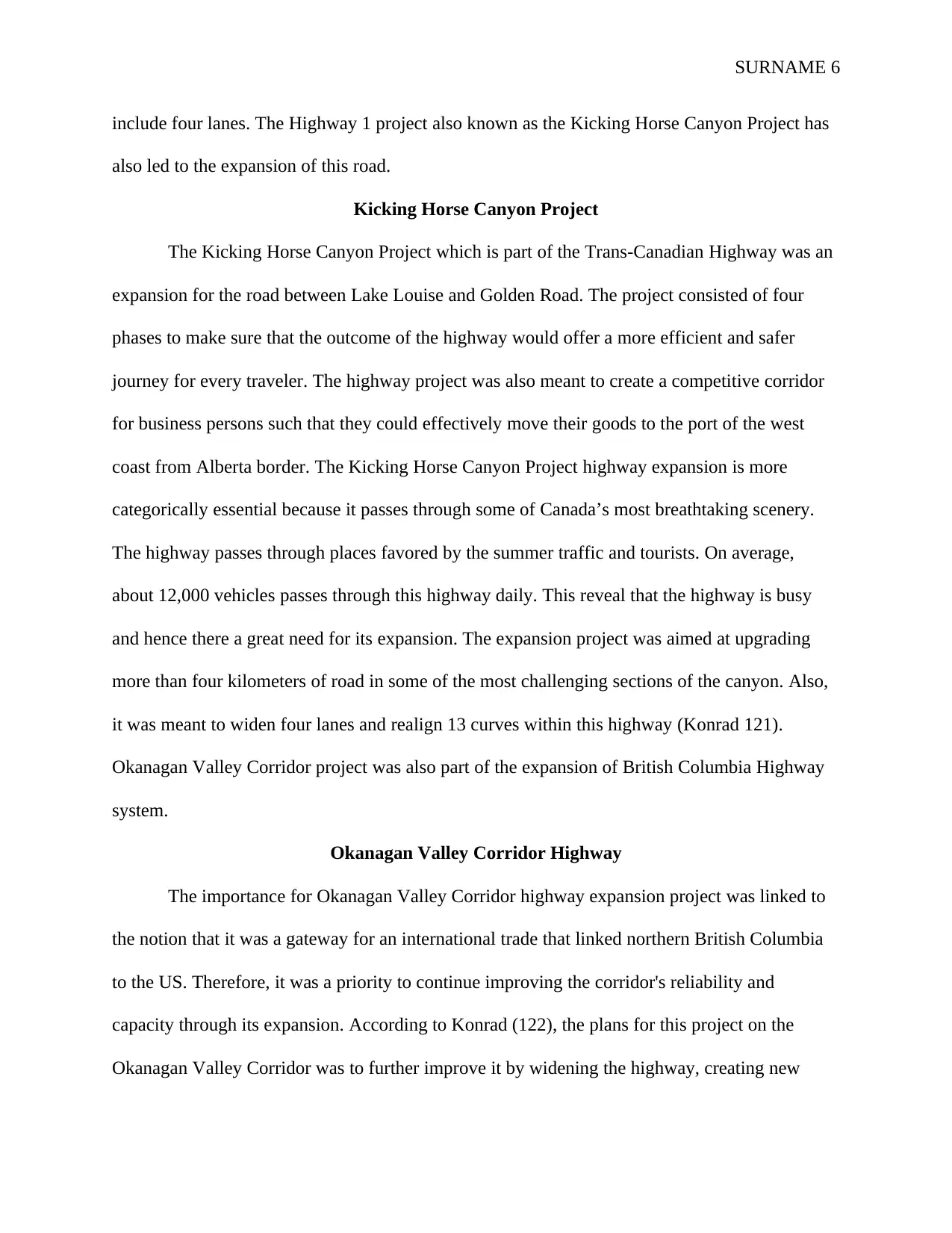
SURNAME 6
include four lanes. The Highway 1 project also known as the Kicking Horse Canyon Project has
also led to the expansion of this road.
Kicking Horse Canyon Project
The Kicking Horse Canyon Project which is part of the Trans-Canadian Highway was an
expansion for the road between Lake Louise and Golden Road. The project consisted of four
phases to make sure that the outcome of the highway would offer a more efficient and safer
journey for every traveler. The highway project was also meant to create a competitive corridor
for business persons such that they could effectively move their goods to the port of the west
coast from Alberta border. The Kicking Horse Canyon Project highway expansion is more
categorically essential because it passes through some of Canada’s most breathtaking scenery.
The highway passes through places favored by the summer traffic and tourists. On average,
about 12,000 vehicles passes through this highway daily. This reveal that the highway is busy
and hence there a great need for its expansion. The expansion project was aimed at upgrading
more than four kilometers of road in some of the most challenging sections of the canyon. Also,
it was meant to widen four lanes and realign 13 curves within this highway (Konrad 121).
Okanagan Valley Corridor project was also part of the expansion of British Columbia Highway
system.
Okanagan Valley Corridor Highway
The importance for Okanagan Valley Corridor highway expansion project was linked to
the notion that it was a gateway for an international trade that linked northern British Columbia
to the US. Therefore, it was a priority to continue improving the corridor's reliability and
capacity through its expansion. According to Konrad (122), the plans for this project on the
Okanagan Valley Corridor was to further improve it by widening the highway, creating new
include four lanes. The Highway 1 project also known as the Kicking Horse Canyon Project has
also led to the expansion of this road.
Kicking Horse Canyon Project
The Kicking Horse Canyon Project which is part of the Trans-Canadian Highway was an
expansion for the road between Lake Louise and Golden Road. The project consisted of four
phases to make sure that the outcome of the highway would offer a more efficient and safer
journey for every traveler. The highway project was also meant to create a competitive corridor
for business persons such that they could effectively move their goods to the port of the west
coast from Alberta border. The Kicking Horse Canyon Project highway expansion is more
categorically essential because it passes through some of Canada’s most breathtaking scenery.
The highway passes through places favored by the summer traffic and tourists. On average,
about 12,000 vehicles passes through this highway daily. This reveal that the highway is busy
and hence there a great need for its expansion. The expansion project was aimed at upgrading
more than four kilometers of road in some of the most challenging sections of the canyon. Also,
it was meant to widen four lanes and realign 13 curves within this highway (Konrad 121).
Okanagan Valley Corridor project was also part of the expansion of British Columbia Highway
system.
Okanagan Valley Corridor Highway
The importance for Okanagan Valley Corridor highway expansion project was linked to
the notion that it was a gateway for an international trade that linked northern British Columbia
to the US. Therefore, it was a priority to continue improving the corridor's reliability and
capacity through its expansion. According to Konrad (122), the plans for this project on the
Okanagan Valley Corridor was to further improve it by widening the highway, creating new
⊘ This is a preview!⊘
Do you want full access?
Subscribe today to unlock all pages.

Trusted by 1+ million students worldwide
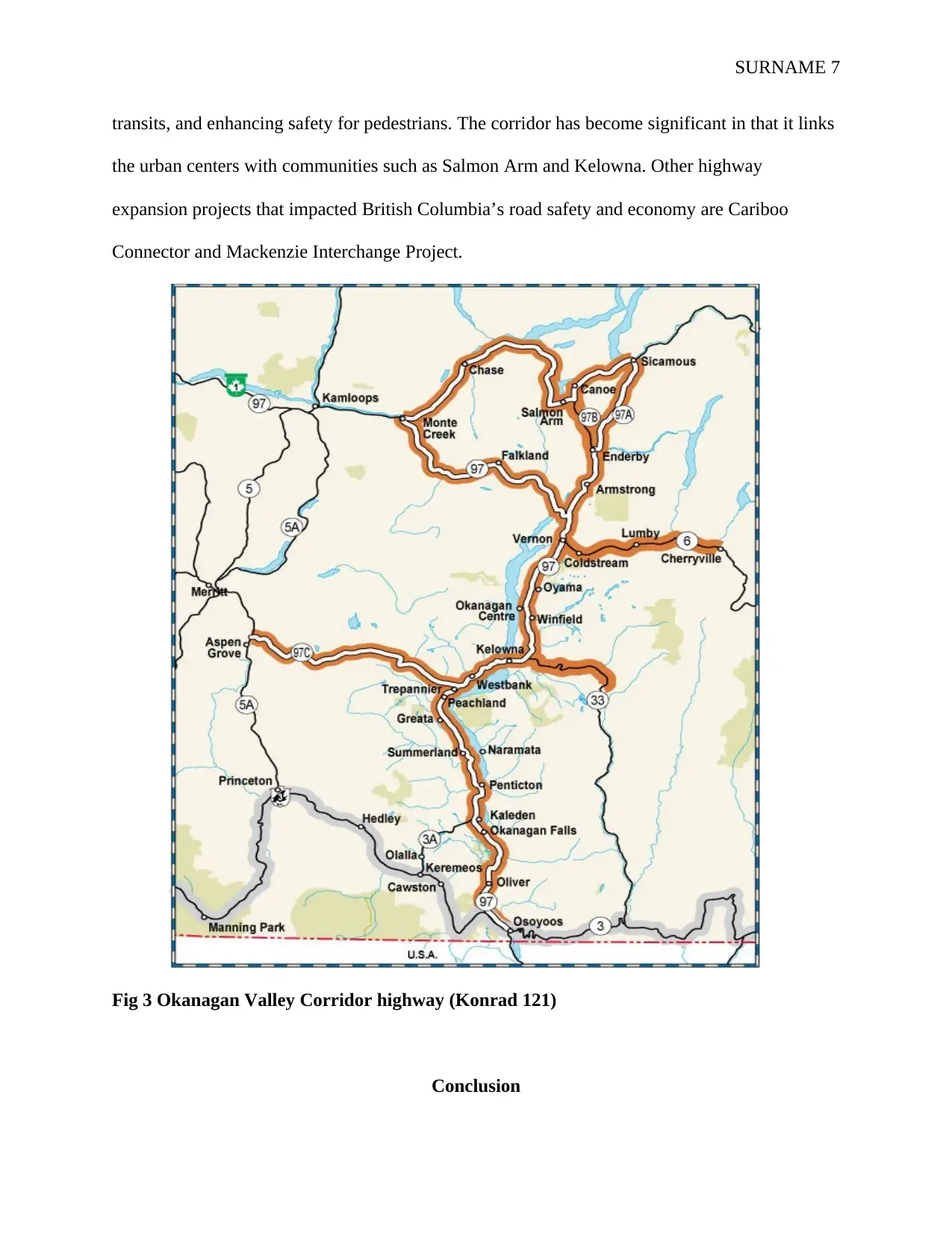
SURNAME 7
transits, and enhancing safety for pedestrians. The corridor has become significant in that it links
the urban centers with communities such as Salmon Arm and Kelowna. Other highway
expansion projects that impacted British Columbia’s road safety and economy are Cariboo
Connector and Mackenzie Interchange Project.
Fig 3 Okanagan Valley Corridor highway (Konrad 121)
Conclusion
transits, and enhancing safety for pedestrians. The corridor has become significant in that it links
the urban centers with communities such as Salmon Arm and Kelowna. Other highway
expansion projects that impacted British Columbia’s road safety and economy are Cariboo
Connector and Mackenzie Interchange Project.
Fig 3 Okanagan Valley Corridor highway (Konrad 121)
Conclusion
Paraphrase This Document
Need a fresh take? Get an instant paraphrase of this document with our AI Paraphraser

SURNAME 8
To sum up, the ministry of roads and infrastructure has always been consistent in
building a highway system that will still be competitive, safe, reliable as well as efficient to
every activity involving transportation businesses across British Columbia. It is for this reason
that highway expansion projects like Highway 16, TransCanada Highway, the Kicking Horse
Canyon Project, and Okanagan Valley Corridor has been part of British Columbia’s investment.
The highway expansion projects offer a more efficient and safer journey for every traveler and
business activities which in turn have economic impacts.
To sum up, the ministry of roads and infrastructure has always been consistent in
building a highway system that will still be competitive, safe, reliable as well as efficient to
every activity involving transportation businesses across British Columbia. It is for this reason
that highway expansion projects like Highway 16, TransCanada Highway, the Kicking Horse
Canyon Project, and Okanagan Valley Corridor has been part of British Columbia’s investment.
The highway expansion projects offer a more efficient and safer journey for every traveler and
business activities which in turn have economic impacts.
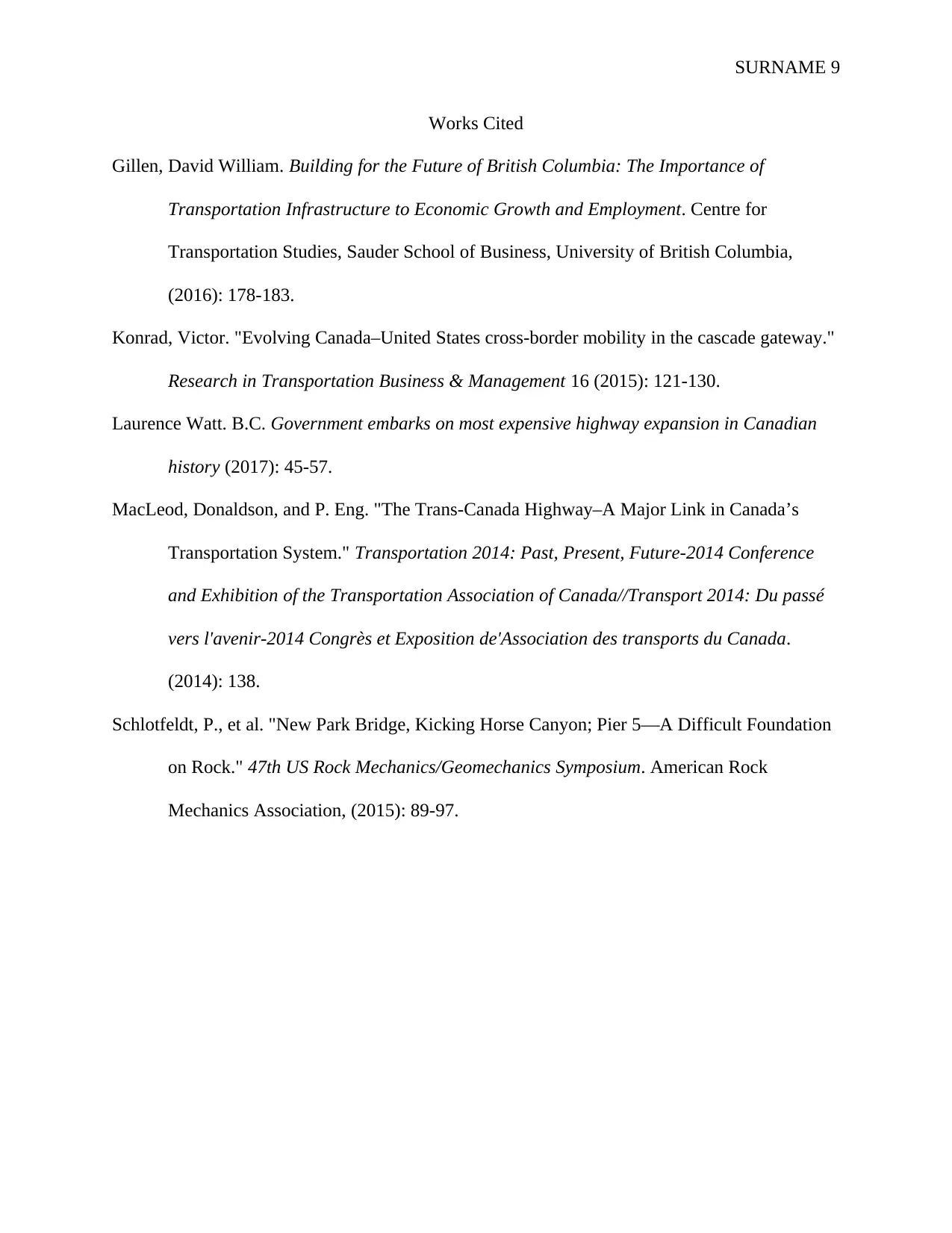
SURNAME 9
Works Cited
Gillen, David William. Building for the Future of British Columbia: The Importance of
Transportation Infrastructure to Economic Growth and Employment. Centre for
Transportation Studies, Sauder School of Business, University of British Columbia,
(2016): 178-183.
Konrad, Victor. "Evolving Canada–United States cross-border mobility in the cascade gateway."
Research in Transportation Business & Management 16 (2015): 121-130.
Laurence Watt. B.C. Government embarks on most expensive highway expansion in Canadian
history (2017): 45-57.
MacLeod, Donaldson, and P. Eng. "The Trans-Canada Highway–A Major Link in Canada’s
Transportation System." Transportation 2014: Past, Present, Future-2014 Conference
and Exhibition of the Transportation Association of Canada//Transport 2014: Du passé
vers l'avenir-2014 Congrès et Exposition de'Association des transports du Canada.
(2014): 138.
Schlotfeldt, P., et al. "New Park Bridge, Kicking Horse Canyon; Pier 5—A Difficult Foundation
on Rock." 47th US Rock Mechanics/Geomechanics Symposium. American Rock
Mechanics Association, (2015): 89-97.
Works Cited
Gillen, David William. Building for the Future of British Columbia: The Importance of
Transportation Infrastructure to Economic Growth and Employment. Centre for
Transportation Studies, Sauder School of Business, University of British Columbia,
(2016): 178-183.
Konrad, Victor. "Evolving Canada–United States cross-border mobility in the cascade gateway."
Research in Transportation Business & Management 16 (2015): 121-130.
Laurence Watt. B.C. Government embarks on most expensive highway expansion in Canadian
history (2017): 45-57.
MacLeod, Donaldson, and P. Eng. "The Trans-Canada Highway–A Major Link in Canada’s
Transportation System." Transportation 2014: Past, Present, Future-2014 Conference
and Exhibition of the Transportation Association of Canada//Transport 2014: Du passé
vers l'avenir-2014 Congrès et Exposition de'Association des transports du Canada.
(2014): 138.
Schlotfeldt, P., et al. "New Park Bridge, Kicking Horse Canyon; Pier 5—A Difficult Foundation
on Rock." 47th US Rock Mechanics/Geomechanics Symposium. American Rock
Mechanics Association, (2015): 89-97.
⊘ This is a preview!⊘
Do you want full access?
Subscribe today to unlock all pages.

Trusted by 1+ million students worldwide
1 out of 9
Your All-in-One AI-Powered Toolkit for Academic Success.
+13062052269
info@desklib.com
Available 24*7 on WhatsApp / Email
![[object Object]](/_next/static/media/star-bottom.7253800d.svg)
Unlock your academic potential
Copyright © 2020–2025 A2Z Services. All Rights Reserved. Developed and managed by ZUCOL.
